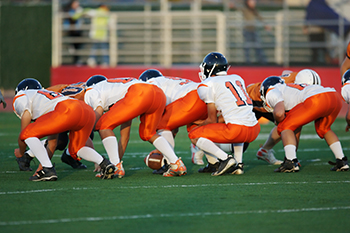
Turf toe is an injury that affects athletes who perform sudden, powerful movements that bend the big toe upward beyond normal range. Pushing off to sprint, jump or move forward in a football or basketball game are common ways that turf toe develops. This action can strain or tear the ligaments and soft tissues surrounding the big toe joint, leading to pain, swelling, and limited movement. Athletes who play on artificial turf are particularly at risk due to the harder, less absorbent surface, though turf toe can also affect dancers, gymnasts, and wrestlers. Footwear with flexible soles can contribute to the risk of turf toe, as it provides less stability during rapid movements. Symptoms may range from mild pain and slight swelling to more severe cases involving ligament rupture and long-lasting joint stiffness. A podiatrist can prescribe a walking boot or other orthotic device to limit joint movement. Surgery, though rare, may be needed in more stubborn or severe cases. If you have a turf toe injury, it is suggested that you schedule an appointment with a podiatrist for an exam and treatment.
Toe pain can disrupt your daily activities. If you have any concerns, contact Mohammad R. Parsa, DPM of Madison Foot Clinic. our doctor can provide the care you need to keep you pain-free and on your feet.
What Causes Toe Pain?
Most severe toe pain is caused due to a sports injury, trauma from dropping something heavy on the toe, or bumping into something rigid. Other problems can develop over time for various reasons.
Toe pain can be caused by one or more ailments. The most common include:
- Trauma
- Sports injury
- Wearing shoes that are too tight
- Arthritis
- Gout
- Corns and calluses
- Hammertoe
- Bunions
- Blisters
- Ingrown toenails
- Sprains
- Fractures (broken bones)
- Dislocations
When to See a Podiatrist
- Severe pain
- Persistent pain that lasts more than a week
- Signs of infection
- Continued swelling
- Pain that prevents walking
Diagnosis
In many cases the cause of toe pain is obvious, but in others, a podiatrist may want to use more advanced methods to determine the problem. These can range from simple visual inspections and sensation tests to X-rays and MRI scans. Prior medical history, family medical history, and any recent physical traumatic events will all be taken into consideration for a proper diagnosis.
Treatment
Treatments for toe pain and injuries vary and may include shoe inserts, padding, taping, medicines, injections, and in some cases, surgery. If you believe that you have broken a toe, please see a podiatrist as soon as possible.
If you have any questions please feel free to contact our office located in Madison, MS . We offer the newest diagnostic tools and technology to treat your foot and ankle needs.
